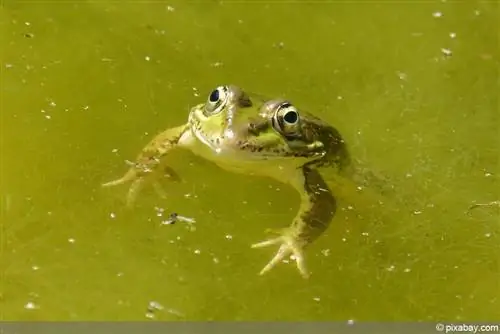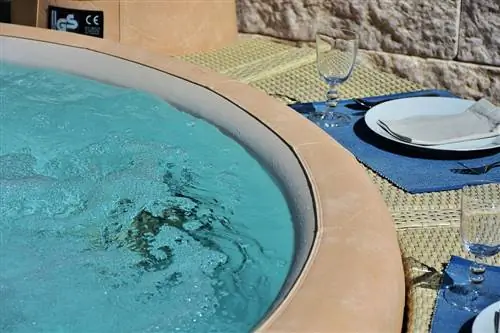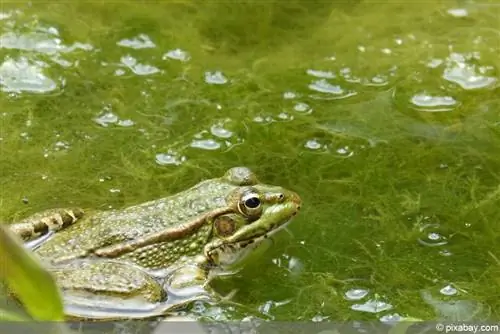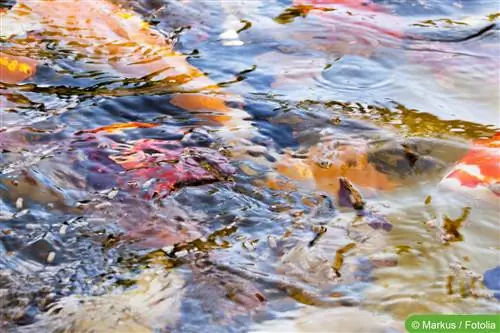- Author admin [email protected].
- Public 2023-12-17 03:39.
- Last modified 2025-06-01 06:48.
The small algae are difficult or impossible to fish out of the water. Remedy can only be achieved with an appropriate filter system.
Causes of cloudy, green water
The green color of the pond water comes from an explosive proliferation of the existing algae. This is called an “algae bloom”. In extreme cases you can only see a few centimeters deep into the water and then everything is cloudy.
A he althy pond helps itself. If it doesn't, the ecological balance is disturbed, something is wrong. There are usually too many nutrients in the water. There are various reasons for this:
- Lots of mud on the ground - from dead plant parts, leaves
- Dead plants in and around the water
- Fish droppings and leftover fish food - the more fish in the pond, the more nutrients
- Lots of rain that washes soil and fertilizer from the garden into the pond
- Well water - often contains a lot of phosphorus
- Too few plants that are responsible for breaking down nutrients
- Lots of sunlight
- Few floating plants
- No pond filter
Immediate measures
Immediate measures can provide quick relief, but they don't help much in the long term. It is important to find out the cause of the algae bloom. It has to be stopped. This usually takes longer. Therefore, something must be done quickly to prevent the pond from completely tipping over.
UVC primary clarifier
If the water in the pond is filtered, i.e. a filter is installed that clarifies it, all sorts of things can be achieved with a UVC primary clarifier. This must be installed in front of the actual filter. The decisive factor is the size, i.e. the wattage, of the UVC lamp. 1 to 2 watts are required per thousand liters of water. If there are fish in the pond, it is 2 to 3 watts per thousand liters, in koi ponds even 4 to 5 watts.
In the UVC clarifier, the floating algae are “clumped” by UV light. These bundles can be filtered out by the pond filter. With the larger particles, the filter does not have the problem that occurs with microscopic algae. They just slip through.
Tip:
UV lamps should be changed annually, even if they are turned off regularly using a timer
Algaecide
There are different algae control agents. You should definitely follow the operating instructions for all of them. Overdoses must be avoided. Chemical flocculants with the active ingredients iron chloride or aluminum s alts work quite well. They ensure that the floating algae stick together by clumping together to form large flakes and so they can be disposed of through the pond filter.
If the flakes sink to the bottom of the pond, they subsequently serve as nutrients for other algae. Flocculants work quickly and are harmless to other pond inhabitants.
Water change
The scholars argue here. Some recommend regular water changes, others say: “just don’t”. New water should bring new nutrients into the pond. It definitely depends on the water itself. Rainwater is often quite acidic. Tap water can be very hard. It always depends on where the water comes from. Well water can be very good, but it can also be very high in phosphorus. The only thing that helps here is a water test.
Eliminate causes
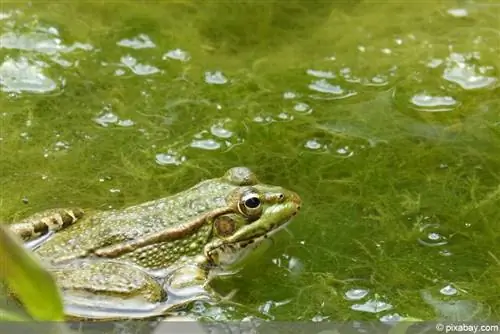
The only thing that helps in the long term is to find out the cause of the green water and address it. The water values provide information about what is wrong. A water sample does not necessarily have to be sent in for analysis; a water analysis set is also sufficient. This is available commercially with good instructions. Good water quality is characterized by the following values:
- pH value - 7 to 8
- Nitrite (NO2) < 0. 15 mg/l
- Nitrate (NO3) < 0.50 mg/l
- KH value - 5 to 12
- GH value - 8 to 12
Once the values have been determined and compared, countermeasures can be initiated. Water conditioners can be used to balance the values. It is important to break down the excess nutrients, especially the phosphates, which are a staple food for algae.
There are different methods for this:
Too little vegetation around the pond and in the pond
Use fast-growing aquatic plants, both floating and underwater plants. They are competitors for food. Nutrients that plants use are no longer available to algae. Also plant the edge of the pond. Plants are absolutely necessary if the water is to remain clean
Too much sunlight, especially in fairly shallow ponds
Shade the water surface, e.g. with floating plants or awnings
Too much mud at the bottom of the pond
- mostly has different causes
- Leaves that fell into the water in autumn and sank. Rotting leaves produce lots of nutrients
- Soil from the garden washed into the pond by rain
- Dust that settles, especially pollen. This is very nutrient-rich.
- Pond soil - for planting
Remove mud, by hand or with a mud vacuum, preferably in early spring. Do not use soil or pond soil in the pond, they contain too many nutrients. Fish off leaves every day before they can sink. Even better is a leaf protection net stretched over the pond.
- Too many fish - Check the population and fish out the fish that are too many. There should be no more than 3 kg of fish per 1,000 liters of water. Fish poop contains a lot of nutrients, the more fish, the more poop. A pond without fish has significantly better water quality and is easier to keep stable. In addition, many other creatures settle here that would have no chance with fish in the water.
- Unused fish food Whatever the fish don't eat in the first few minutes sinks to the bottom and stays there. Another source of nutrients. Use low-phosphate fish food and feed only a little. The fish should catch their own food, so they stay sporty.
- Dead fish or animals in or near the water - the decomposition creates tons of nutrients. The animals have to get out of the water.
- Dead plants - decomposing releases many nutrients, so remove plants
- Dead algae, e.g. filamentous algae, when these decompose, a lot of nutrients are also released. The algae must be fished out, otherwise they will form the basis for another algae plague.
- Poor water clarification due to missing filter. A filter must ensure good water quality, especially in fish ponds. When choosing, you should seek advice from an expert.
- Too much acidic rainwater in the pond. Change the water, replace about 30 percent. Use nutrient-poor water or, if this is not available, use a stabilizing agent.
Prevention
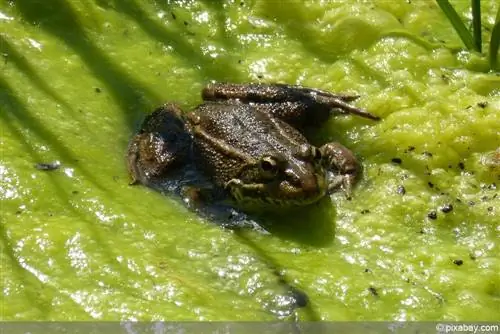
Prevention is always better than cure. It is therefore important to prevent or avoid too many nutrients in the pond. This starts with the planning of the pond, for example with the location or whether the pond should be made slightly higher so that no soil can be washed into the water.
- Plan the pond so that parts of it are shaded. Deciduous trees nearby cause problems (falling leaves in autumn, pollen in spring). Evergreen trees are better.
- Ponds are often embedded in a depression. This looks good, but it has the disadvantage that during heavy rains, soil from the surrounding beds is often washed into the water. So it's better to build the pond a little higher.
- Be sure to set up a capillary barrier so that the water is separated from the earth around it. Water and earth must not come into contact. The lock must also be functional, so always check it!
- Many plants on and in the pond remove nutrients from the water that they need for their growth. These are then no longer available to the algae. The plants act as a biological filter. Fast-growing plants are cheap, but they shouldn't be allowed to grow rampant. This causes problems again, albeit of a different kind. Floating plants are also ideal for shading the water surface.
- Pond Care - regular pond care can prevent nutrients from getting into the pond. The plants must be checked regularly for dead parts. These must be removed because when they decompose they form new nutrients. Remove leaves before they sink to the ground. It's best to fish them out every day in the fall. If the leaves are saturated with water, they sink. Then it's very difficult to get them out.
- Install an appropriate filter, especially if fish live in the pond.
Tip:
A UVC pre-clarifier or simply lamps that emit UV-C light are often recommended. The pump directs the water into a special container where it is massively irradiated. The light kills algae, germs and spores, but unfortunately also bacteria. Their job is to decompose the algae and convert toxic nitrite into harmless nitrate. So every thing has two sides, but that is well known. Perhaps more harmless methods should be tried before resorting to such invasive measures! A filter system with a circulation pump is usually enough to prevent the pond from turning green.
Conclusion
Pond water is never absolutely clear, at least not he althy water. That's not even necessary. A visibility depth of 1 meter is usually sufficient. If the pond water turns green, this indicates floating algae. Under good conditions, these multiply quickly and the water becomes greener and greener. It is important to find out the cause. There are usually simply too many nutrients in the water that the algae need to develop. If you lower the nutrients, the algae will be starved. They die, but should be removed from the water because decomposing algae provide lots of new nutrients. It is often fish that provide the nutrient input through feces, leftover food and dead specimens. But soil, rainwater, leaves, pollen, sun and missing plants can also be the cause. A pond takes work, and you have to be clear about that right from the start. If you don't take care of it regularly, you shouldn't be surprised. Chemistry usually brings quick help, but it is not permanent. On the contrary, after an initial improvement the situation usually gets worse. Beware of these quick fixes. Better to think long-term!

